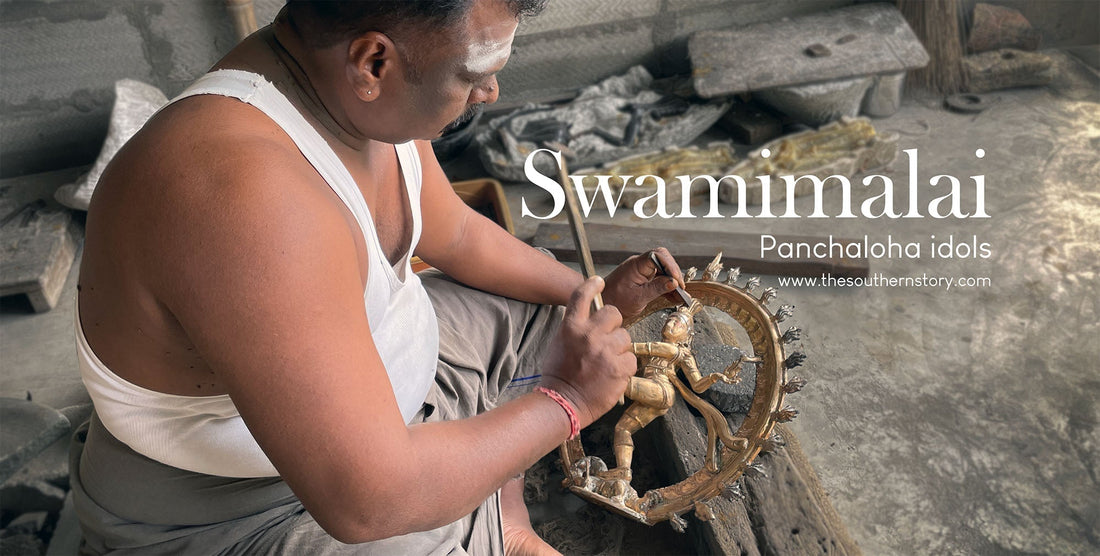
The Timeless Art of Swamimalai Bronze Icons: Crafting Divinity in Metal
Hidden in the heart of Tamil Nadu, in a quiet town called Swamimalai, lives a centuries-old legacy that turns molten metal into sacred art. These are not just statues—they are living traditions, shaped by fire, devotion, and unmatched craftsmanship.
A Sacred Heritage
Swamimalai is one of the six sacred abodes of Lord Murugan, but it is equally revered as the birthplace of the Chola bronze casting tradition. For over 1,000 years, artisans here have been creating “Panchaloha” idols—sacred icons made from an alloy of five metals: gold, silver, copper, zinc, and iron.
This art is so unique that it’s protected by the Geographical Indication (GI) tag, preserving its authenticity and origin.
The Lost-Wax Technique
Each icon is crafted using an ancient method known as Madhu Uchchishtta Vidhana, also referred to as lost-wax casting. Here’s how it works:
-
Design in Wax: A detailed model of the deity is sculpted in beeswax.
-
Clay Coating: Layers of special Swamimalai clay are applied over the wax model to create a mold.
-
Firing: The mold is heated, causing the wax to melt away and leave a cavity.
-
Metal Casting: The Panchaloha alloy is poured into the mold.
-
Finishing: After cooling, the clay is broken, and the raw idol is hand-polished and detailed.
Each piece is one-of-a-kind. No two idols are ever exactly alike.
Divinity Meets Craftsmanship
Swamimalai bronze icons are not mass-produced products. They are spiritually significant, Vastu-aligned artworks, often consecrated in temples and homes around the world.
Popular deities include:
-
Lord Nataraja: Symbol of cosmic dance and Shiva’s power
-
Goddess Lakshmi: The bringer of wealth and prosperity
-
Lord Vishnu and Dasavataram: Stories of cosmic order
-
Murugan with Vel: The warrior god of the Tamil people
Sacred Postures and Mudras : The Language of Bronze Idols
When you look at a South Indian bronze idol, be it Nataraja, Ganesha, or Lakshmi, what you see is not just a statue. Each posture (asana) and hand gesture (mudra) is packed with spiritual meaning, iconographic tradition, and cosmic symbolism.
Let’s decode the deeper meanings behind the postures and mudras found in Swamimalai bronze icons.
What are Mudras?
Mudras are symbolic hand gestures used in Indian iconography, dance, and meditation. In idols, they are used to convey spiritual truths or divine qualities. Every mudra has a name and a purpose.
Here are some of the most commonly seen mudras:
Abhaya Mudra (Gesture of Protection)
-
Hand Position: Right hand raised, palm facing forward.
-
Meaning: “Do not fear.” It symbolizes protection, reassurance, and divine shelter.
-
Commonly Seen In: Lord Vishnu, Lord Shiva, and many standing deities
Varada Mudra (Gesture of Giving/Compassion)
-
Hand Position: Palm open and facing downward
-
Meaning: Represents charity, grace, and the granting of boons
-
Commonly Seen In: Goddess Lakshmi, Lord Ganesha
Dhyana Mudra (Gesture of Meditation)
-
Hand Position: Both hands rest in the lap, one over the other, palms upward
-
Meaning: Represents inner concentration, stillness, and spiritual wisdom
-
Commonly Seen In: Lord Buddha, Sage Agastya, Shiva in meditative form
Gaja Hasta or Gaja Mudra (Elephant Trunk Gesture)
-
Used in: Ganesha icons
-
Meaning: Resembles the trunk of an elephant and symbolizes power and protection.
Nataraja’s Dynamic Posture
Lord Nataraja, the cosmic dancer, is a masterpiece of posture and mudra:
-
Upper Right Hand: Holds the damaru (drum) — symbol of creation
-
Upper Left Hand: Holds fire — symbol of destruction
-
Lower Right Hand: Abhaya mudra
-
Lower Left Hand: Points to the raised foot — symbolizing liberation
-
Right Foot: Crushing Apasmara (ignorance)
- Left Foot: Raised — symbol of moksha (salvation)
Every movement here symbolizes the cyclical rhythm of the universe.
Standing, Sitting & Dancing: Meaningful Postures
-
Sthanaka (Standing): Calm, protective, balanced energy
-
Asana (Sitting): Meditative, grounded, often used for deities like Lakshmi, Saraswati
-
Nritya (Dancing): Dynamic, transformative energy (as seen in Nataraja)
More Unique Iconic Details
-
Shiva’s Third Eye: Represents higher consciousness and divine perception
-
Vishnu’s Conch (Shankha) & Disc (Chakra): Sound of the cosmos and power of time
-
Lakshmi’s Coins Flowing from Hand: Unending abundance and generosity
-
Murugan’s Vel (spear): Sharpness of wisdom and destruction of evil
Why This Matters
When you understand the symbolism in your idol, it becomes more than décor—it becomes a source of energy, meaning, and daily connection. Each gesture carries intention, and every icon is a silent teacher.
A Global Treasure
Today, Swamimalai icons are not only cherished across India but are also exported to art collectors, temples, and spiritual seekers in the US, Europe, and Southeast Asia. Owning one is like holding a piece of Indian history and devotion in your hands.
Why Buy from Us?
We work directly with the traditional families of Swamimalai who have been perfecting this art for generations. Each idol you see in our store is:
-
100% handmade
-
Made using authentic Panchaloha
-
Certified for cultural and spiritual integrity
-
Carefully packed and shipped worldwide
Bring Home a Blessing Today
Explore our curated collection of Swamimalai bronze idols—from majestic Natarajas to serene Vishnus. Each piece tells a story, carries a soul, and brings a divine presence to your space.
🛒 Shop Swamimalai Bronze Icons Now












